In the realm of raptors, the diversity of hunting strategies, adaptations, and habitats is vividly exemplified by the Merlin and the Peregrine Falcon.
These avian predators, each possessing a unique set of characteristics, captivate the imagination of both ornithologists and enthusiasts alike.
While the Merlin’s agility and forested prowess contrast with the Peregrine Falcon’s astonishing speed and open-sky dominance, their shared family traits intertwine with individual traits to create an intricate tapestry of nature’s ingenuity.
Exploring their differences enriches our understanding of how these remarkable species have evolved to thrive within their distinct ecological niches.
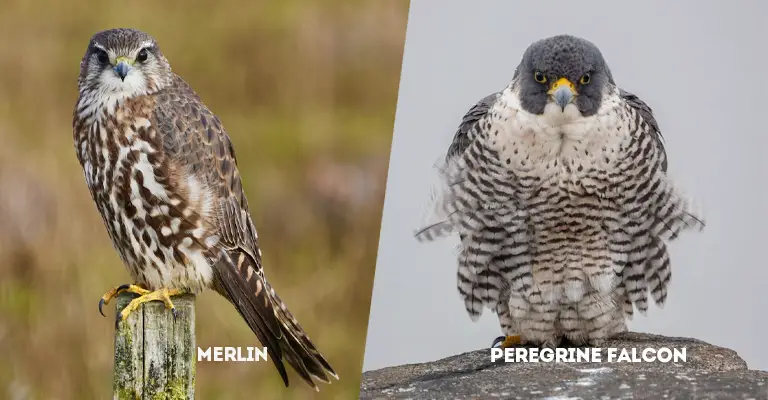
Key Differences Between Merlin and Peregrine Falcon
Merlin and Peregrine Falcon are both birds of prey, but they have distinct characteristics and differences. Let’s compare them:
Size
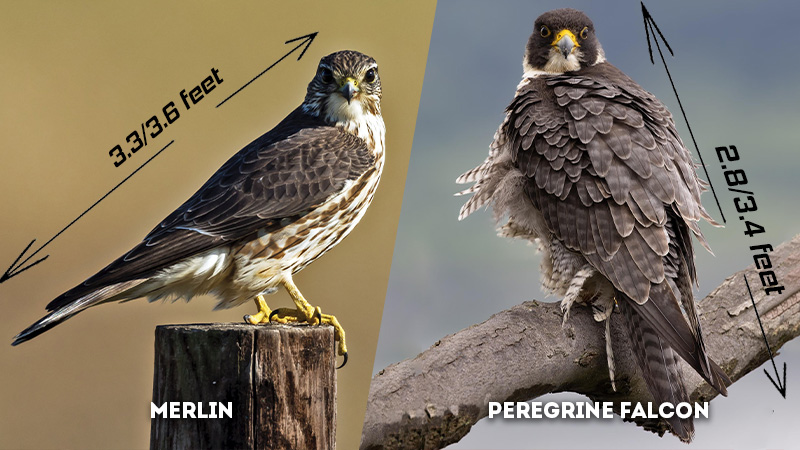
- Merlin: Merlins are smaller falcons, with an average wingspan ranging from 2.8 to 3.4 feet. They weigh around 5.3 to 8.5 ounces.
Their compact size allows them to navigate through trees and shrubs, facilitating their hunting style, which often involves chasing smaller birds and insects in forested areas. - Peregrine Falcon: Peregrine Falcons, on the other hand, are larger. Their wingspan averages 3.3 to 3.6 feet, and they weigh between 1.1 to 2.3 pounds.
Their robust build and broader wings aid their exceptional aerial abilities, including high-speed dives to catch medium-sized birds in a variety of habitats.
Wingspan
- Merlin: Merlins, characterized by their agility, boast a wingspan ranging from 2.8 to 3.4 feet. This relatively compact wingspan suits their behavior of maneuvering through dense vegetation during hunts.
Their smaller size allows them to navigate intricately through forested areas and hunt smaller prey like songbirds and insects with precision. - Peregrine Falcon: Peregrine Falcons, renowned for their astonishing aerial abilities, exhibit a wingspan averaging between 3.3 to 3.6 feet.
Their broader wings are a crucial adaptation for their high-speed pursuits, particularly during dramatic stoops or dives from great heights.
This larger wingspan enables them to maintain stability and control while chasing down medium-sized birds, their primary prey, in various landscapes.
Weight
- Merlin: Weighing approximately 5.3 to 8.5 ounces, Merlins possess a lighter frame. This lower weight complements their agility, enabling them to swiftly navigate obstacles and employ rapid aerial maneuvers during hunting.
- Peregrine Falcon: Peregrine Falcons, with their larger size, have a weight range of about 1.1 to 2.3 pounds. This greater weight contributes to their ability to generate incredible diving speeds and kinetic energy, which aids in overtaking and capturing their prey mid-air.
Chest & Wings
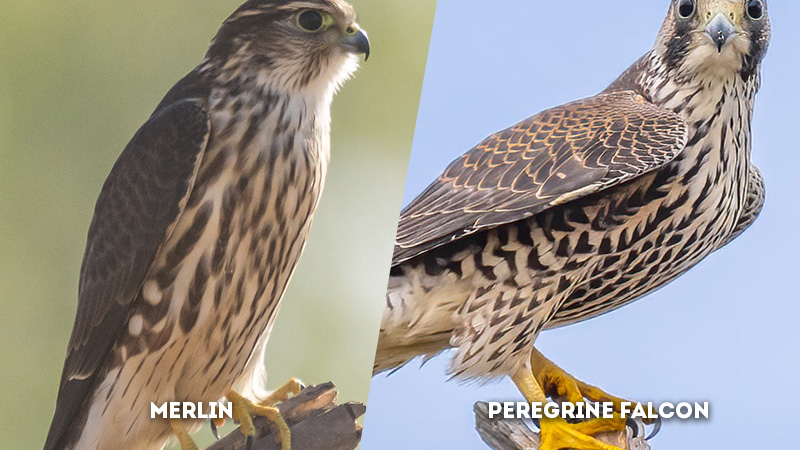
- Merlin: Merlin’s physique is characterized by its slimmer chest and more modest wingspan, spanning from 2.8 to 3.4 feet. This body structure aligns with its preference for navigating through intricate forest environments.
The relatively compact wings are suited for weaving through trees and shrubs, aiding the Merlin’s hunting style focused on smaller prey like songbirds and insects. - Peregrine Falcon: Peregrine Falcons exhibit a striking contrast in chest and wingspan attributes. Their broader wings, spanning 3.3 to 3.6 feet, are a defining feature that contributes to their aerial mastery. These wings are tailored for high-speed dives, or stoops, from significant altitudes.
Appearance
- Merlin: The Merlin’s appearance is more streamlined due to its sleeker chest and smaller stature. This falcon’s physique is often described as lithe, tailored for swift and precise flight.
While its appearance lacks the distinctive hooded look of the Peregrine, the Merlin emanates an aura of agility and sharpness, well-suited to its forested hunting grounds. - Peregrine Falcon: The Peregrine Falcon’s appearance is instantly recognizable due to its hooded countenance and prominent facial markings.
Sporting a dark cap on its head, the Peregrine’s face gives the impression of being cloaked in a hood, hence the name. The dark markings around its eyes, often likened to a strong mustache, contribute to its distinctive appearance.
Facial Markings
- Merlin: While the Merlin lacks the bold facial markings of the Peregrine, it doesn’t mean its appearance lacks distinction. With subtler markings around the eyes, Merlin’s visage exudes an air of focus and intensity.
These markings, though less pronounced, play a role in camouflaging the falcon as it darts through foliage in pursuit of prey. - Peregrine Falcon: Facial markings are a highlight of the Peregrine Falcon’s appearance. The dark markings surrounding its eyes not only contribute to its hooded look but also aid in reducing glare from the sun during high-speed dives.
These markings also serve as a visual signal of the Peregrine’s prowess, marking it as a dominant aerial predator.
Hunting Style
- Merlin: Merlins are adept at maneuvering through dense vegetation, a skill that complements their hunting style.
They rely on agility and surprise to chase down smaller prey like songbirds and insects. Their hunting often involves swift pursuits through forests and open areas, using cover to their advantage before launching precise attacks. - Peregrine Falcon: Peregrine Falcons are renowned for their spectacular aerial hunting style. They employ high-speed dives, or stoops, from great heights to catch medium-sized birds in mid-air.
Their remarkable speed, which can exceed 240 mph during dives, allows them to overtake and seize prey with precision, showcasing their mastery of the open skies.
Hunting Range
- Merlin: Merlins tend to focus on hunting within relatively smaller areas. They often stake out territories in woodlands and open spaces, pursuing smaller birds and insects that are abundant in these environments.
- Peregrine Falcon: Peregrine Falcons have a broader hunting range due to their larger size and versatile hunting strategy.
They can be found hunting in diverse landscapes, including coastal cliffs, mountains, and urban environments, where they target medium-sized birds that inhabit these regions.
Habitat
- Merlin: Merlins are often associated with forested areas and open spaces. Their agility allows them to navigate through trees and shrubs as they hunt smaller prey. They tend to inhabit regions with ample cover for stealthy approaches.
- Peregrine Falcon: Peregrine Falcons are adaptable to a wide range of habitats. While they are frequently associated with cliffs in more remote locations, they have also shown a remarkable ability to thrive in urban settings, nesting on skyscrapers and hunting in city environments where pigeons and other suitable prey are abundant.
Global Distribution
- Merlin: Merlins have a relatively wide distribution, found across various parts of North America, Europe, Asia, and even northern Africa. Their presence is noted in a diverse range of ecosystems, from boreal forests to grasslands.
- Peregrine Falcon: Peregrine Falcons are one of the most widespread birds of prey, found on nearly every continent except Antarctica.
Their adaptability to different habitats and hunting styles has allowed them to thrive in diverse regions, making them a truly global species.
Flying Speed
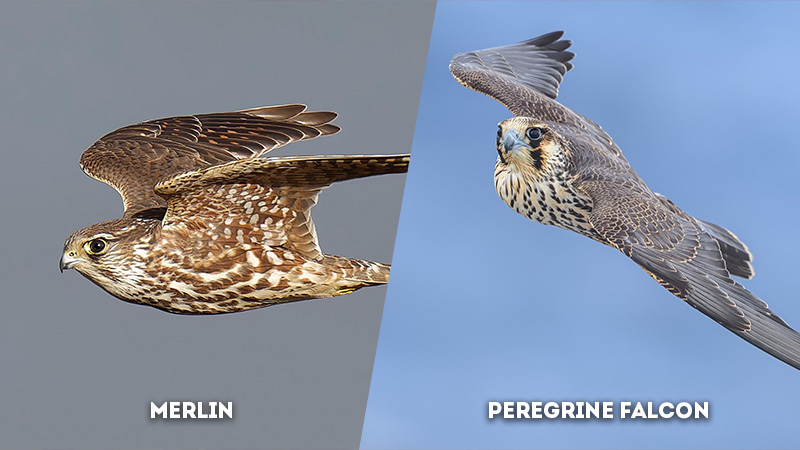
- Merlin: Merlins are agile fliers, capable of rapid and precise movements. While specific diving speeds are not as notable as in the Peregrine Falcon, the Merlin’s agility shines in its ability to swiftly navigate through dense vegetation during hunting pursuits.
Its quick bursts of speed and maneuverability make it an adept hunter in forested landscapes, allowing it to surprise and catch smaller birds and insects with swift, calculated attacks. - Peregrine Falcon: Peregrine Falcons are celebrated for their exceptional flying speeds, particularly during their trademark high-speed dives.
These stoops, which can reach speeds of over 240 mph (386 km/h), enable them to chase down and seize medium-sized birds in mid-air.
This incredible speed is a result of their specialized wing structure and adaptations, showcasing their prowess as one of the fastest animals on Earth.
Preferred Prey
- Merlin: Merlins target smaller prey such as songbirds and insects. Their smaller size and hunting style align with pursuing agile quarry that can be found in wooded areas.
They rely on surprise attacks and their ability to weave through trees and shrubs to capture their preferred prey. - Peregrine Falcon: Peregrine Falcons have a preference for medium-sized birds. Their high-speed hunting strategy, involving aerial stoops, is ideally suited for overtaking and capturing birds in flight.
They often target birds such as pigeons and doves, which are abundant in urban environments as well as in their natural habitats.
Behavior
- Merlin: Merlins are known for their versatile hunting behavior. They are highly adaptable predators, able to switch between flying and perching hunts as they pursue smaller prey.
They often exhibit rapid bursts of flight, utilizing cover and terrain to their advantage during pursuits. Merlins are also known for their skill in aerial acrobatics, making them impressive and nimble hunters. - Peregrine Falcon: Peregrine Falcons’ behavior is marked by their spectacular aerial displays during hunting. Their characteristic high-speed dives showcase their prowess in the skies.
They engage in soaring flights and are capable of both sudden bursts of speed and sustained glides. Their behavior is optimized for precision and speed, making them remarkable predators of the open air.
Territorial
- Merlin: Merlins are territorial birds, defending smaller areas that contain their preferred hunting grounds. They stake out territories in woodlands and open spaces, which provide the resources needed to sustain their diet of smaller birds and insects.
- Peregrine Falcon: Peregrine Falcons have larger territories that encompass their diverse hunting ranges. These territories include cliffs, urban areas, and other landscapes rich in prey. Their wide-ranging habitats are reflected in the extent of their territorial boundaries.
Nesting Sites
- Merlin: Merlins typically nest in trees and shrubs. They select concealed locations that provide cover and safety for their nests.
Their choice of nesting sites often aligns with their forested habitats, enabling them to raise their young in environments suited to their hunting style. - Peregrine Falcon: Peregrine Falcons are known for their affinity for nesting on cliffs, mirroring their natural habitats.
However, they’ve also demonstrated their adaptability by nesting on human-made structures in urban areas, such as tall buildings and bridges.
This ability to nest in diverse locations reflects their flexibility in exploiting resources and expanding their range.
Voice
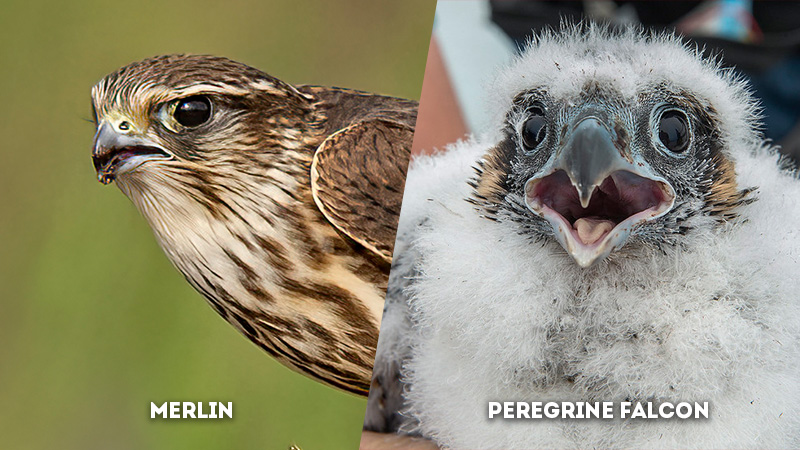
- Merlin: The Merlin’s voice is characterized by high-pitched chattering calls. These vocalizations are often used for communication between mates and during territorial disputes. Their calls can be heard echoing through their woodland and open habitat territories.
- Peregrine Falcon: Peregrine Falcons produce distinctive calls that include a series of shrill “kak kak” notes. These calls are utilized for various purposes, such as communicating with their mates, defending their territories, and interacting with their fledglings.
Migrations
- Merlin: Merlins exhibit variable migration patterns depending on their location and the availability of prey.
While some populations are migratory and travel significant distances between breeding and wintering grounds, others are more sedentary and remain in their breeding territories year-round. - Peregrine Falcon: Peregrine Falcons are known for their remarkable long-distance migrations. Many populations undertake extensive journeys, traveling thousands of miles between their breeding and wintering areas. This migratory behavior allows them to exploit diverse prey populations in different regions.
Conservation Status
- Merlin: The Merlin generally maintains a stable conservation status across its range. While localized threats, such as habitat loss and disturbance, can impact local populations, the species as a whole is not currently considered to be of immediate conservation concern.
- Peregrine Falcon: The Peregrine Falcon has experienced varying conservation statuses throughout history.
In the mid-20th century, the species faced a significant decline due to the widespread use of pesticides like DDT, which caused eggshell thinning and reproductive failure.
Diving Speed
- Merlin: While the Merlin is not known for the extraordinary diving speeds seen in the Peregrine Falcon, its agility in flight and maneuvering capabilities enable it to rapidly change direction during pursuits. This allows it to weave through obstacles in its forested hunting grounds.
- Peregrine Falcon: The Peregrine Falcon’s diving speed is one of its most astounding features. It is capable of reaching speeds exceeding 240 mph (386 km/h) during its high-speed stoops, making it one of the fastest animals on the planet. This remarkable speed is a critical adaptation for capturing fast-moving prey in mid-air.
Adaptations
- Merlin: The Merlin’s adaptations include its compact size, agility, and sharp vision. These traits enable it to navigate through dense vegetation and engage in rapid, surprise attacks on smaller birds and insects. Its camouflage and maneuverability are crucial for ambushing prey in its woodland habitats.
- Peregrine Falcon: The Peregrine Falcon’s adaptations are geared towards high-speed aerial hunting. Its large, powerful wings, coupled with its pointed beak and strong talons, equip it for capturing prey in mid-air.
Its exceptional vision and ability to adjust its wing shape during dives contribute to its precision and effectiveness as an aerial predator.
Merlin Vs Peregrine Falcon: Comparison Table
| Aspect | Merlin | Peregrine Falcon |
|---|---|---|
| Size | Smaller | Larger |
| Wingspan | 2.8 to 3.4 feet | 3.3 to 3.6 feet |
| Weight | 5.3 to 8.5 ounces | 1.1 to 2.3 pounds |
| Chest & Wings | Slimmer wings, body | Broader wings, chest |
| Appearance | Less hooded look | Distinct hooded look |
| Facial Markings | Less prominent | Dark markings around eyes |
| Hunting Style | Maneuvers through trees | High-speed dives |
| Hunting Range | Songbirds, insects | Medium-sized birds |
| Habitat | Forests, open spaces | Various habitats |
| Global Distribution | Varied regions | Found on most continents |
| Flying Speed | Agile flier | Extremely fast in dives |
| Preferred Prey | Smaller birds, insects | Medium-sized birds |
| Behavior | More tree-based hunting | Aerial hunting mastery |
| Territorial | Defends smaller areas | Larger territories |
| Nesting Sites | Trees, shrubs | Cliffs, urban sites |
| Voice | High-pitched chattering | Shrill, “kak kak” calls |
| Migrations | Some migrate | Migrate long distances |
| Conservation Status | Generally stable | Recovering from decline |
| Diving Speed | N/A | Over 240 mph (386 km/h) |
| Adaptations | Maneuverability | High-speed aerial hunting |
Frequently Asked Questions
Yes, Merlins and Peregrine Falcons can overlap in some regions, especially during migration. While their preferred habitats differ, there are areas where their ranges intersect, allowing for potential interactions.
Merlins often nest in trees and shrubs, selecting concealed locations for protection. Peregrine Falcons prefer cliff ledges, but urban populations have adapted to nesting on tall buildings and bridges for accessibility and safety.
Yes, both species can encounter threats such as habitat loss due to urbanization, collisions with human-made structures, and pesticide exposure. Peregrine Falcons historically faced severe decline due to DDT, but conservation efforts have led to recovery.
Merlins use high-pitched chattering calls for communication, often heard during territorial disputes. Peregrine Falcons produce distinctive “kak kak” calls for various purposes, including mate communication and territory defense.
Yes, both species can exhibit flexibility in their hunting techniques. While Merlins are adaptable in pursuing prey through varied habitats, Peregrine Falcons can adjust their flight behaviors based on prey availability and environmental conditions.
To Recap
In the soaring skies and secretive woodlands, the Merlin and the Peregrine Falcon stand as testaments to the incredible adaptability and diversity within the world of falcons.
Their contrasting attributes, from hunting techniques to habitat preferences, reflect the intricate balance of nature’s design. These two majestic species remind us that every ecosystem accommodates a symphony of roles, each finely tuned to its environment.
By delving into their differences, we not only uncover the fascinating intricacies of avian life but also deepen our appreciation for the complex interplay that sustains our planet’s rich tapestry of life.